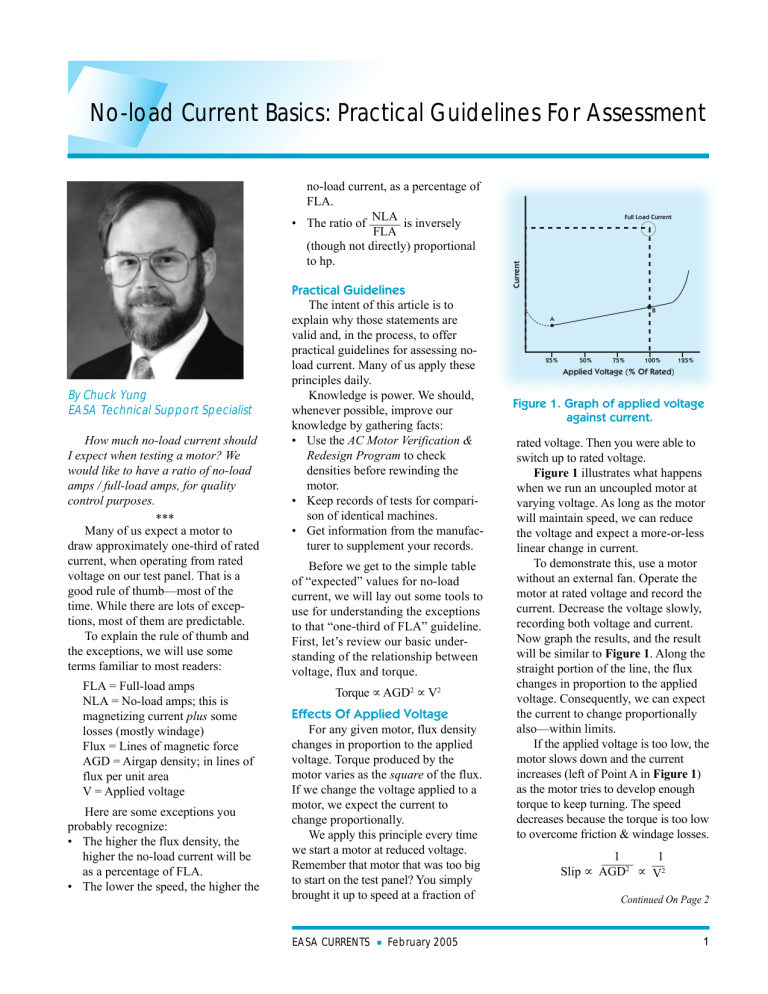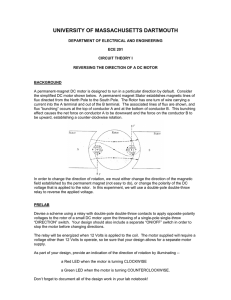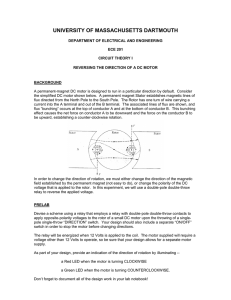No-load Current Basics: Practical Guidelines for Assessment
advertisement

No-load Current Basics: Practical Guidelines For Assessment By Chuck Yung EASA Technical Support Specialist How much no-load current should I expect when testing a motor? We would like to have a ratio of no-load amps / full-load amps, for quality control purposes. *** Many of us expect a motor to draw approximately one-third of rated current, when operating from rated voltage on our test panel. That is a good rule of thumb—most of the time. While there are lots of exceptions, most of them are predictable. To explain the rule of thumb and the exceptions, we will use some terms familiar to most readers: FLA = Full-load amps NLA = No-load amps; this is magnetizing current plus some losses (mostly windage) Flux = Lines of magnetic force AGD = Airgap density; in lines of flux per unit area V = Applied voltage Here are some exceptions you probably recognize: • The higher the flux density, the higher the no-load current will be as a percentage of FLA. • The lower the speed, the higher the Practical Guidelines The intent of this article is to explain why those statements are valid and, in the process, to offer practical guidelines for assessing noload current. Many of us apply these principles daily. Knowledge is power. We should, whenever possible, improve our knowledge by gathering facts: • Use the AC Motor Verification & Redesign Program to check densities before rewinding the motor. • Keep records of tests for comparison of identical machines. • Get information from the manufacturer to supplement your records. Before we get to the simple table of “expected” values for no-load current, we will lay out some tools to use for understanding the exceptions to that “one-third of FLA” guideline. First, let’s review our basic understanding of the relationship between voltage, flux and torque. Torque ∝ AGD2 ∝ V2 Effects Of Applied Voltage For any given motor, flux density changes in proportion to the applied voltage. Torque produced by the motor varies as the square of the flux. If we change the voltage applied to a motor, we expect the current to change proportionally. We apply this principle every time we start a motor at reduced voltage. Remember that motor that was too big to start on the test panel? You simply brought it up to speed at a fraction of EASA CURRENTS ■ February 2005 Full Load Current Current no-load current, as a percentage of FLA. NLA • The ratio of _____ is inversely FLA (though not directly) proportional to hp. B A 25% 50% 75% 100% 125% Applied Voltage (% Of Rated) Figure 1. Graph of applied voltage against current. rated voltage. Then you were able to switch up to rated voltage. Figure 1 illustrates what happens when we run an uncoupled motor at varying voltage. As long as the motor will maintain speed, we can reduce the voltage and expect a more-or-less linear change in current. To demonstrate this, use a motor without an external fan. Operate the motor at rated voltage and record the current. Decrease the voltage slowly, recording both voltage and current. Now graph the results, and the result will be similar to Figure 1. Along the straight portion of the line, the flux changes in proportion to the applied voltage. Consequently, we can expect the current to change proportionally also—within limits. If the applied voltage is too low, the motor slows down and the current increases (left of Point A in Figure 1) as the motor tries to develop enough torque to keep turning. The speed decreases because the torque is too low to overcome friction & windage losses. 1 1 _____ __ Slip ∝ AGD2 ∝ V2 Continued On Page 2 1 No-load Current Basics: Practical Guidelines For Assessment Continued From Page 1 Next slowly raise the voltage above rated voltage, again recording the voltage and current. As the voltage increases, the current increase will remain linear until we reach saturation (Point B, Figure 1). When the stator core becomes saturated, it takes a disproportionate amount of current to increase the level of flux. Between Points A and B, voltage graphed against current will be moreor-less linear. That is one reason we should test run all repaired motors at rated voltage, and record the voltage and current on all phase leads. The noload test run is a critical step in quality assurance. (See the February 2004 CURRENTS article “Avoiding High No-Load Amps.”) Some manufacturers are very frugal with active materials (steel and copper cost money, after all), and some applications require a high hp or kW rating in a small physical package. From Figure 1, we can expect such a “high flux” motor to draw relatively high no-load current. It is also more sensitive to higher-thanrated voltage—which may push the core into saturation. On the other 2-pole flux path hand, the motor is usually more forgiving of under-voltage conditions, compared to a conservatively fluxed motor. We can expect designs that operate at or near the knee of the saturation curve to draw higher no-load current than those operating along the linear portion of the curve. What about conservative designs, such as older U-frame machines? Those, as well as two-pole machines, motors designed for high ambient temperatures (kiln motors) or high altitude use, are deliberately “fluxed low” —meaning they are designed to operate well below the knee of that flux curve. We should expect relatively low no-load current. While more tolerant of high voltage, they are more susceptible to low voltage conditions. Different Designs Affect Rule Four-pole machines dominate industry, so the “one-third of rated current” rule is appropriate. But while one 4-pole motor might be a conservative design for a variety of reasons, another might be fluxed higher. So we should expect the conservative design motor to draw a bit less than our rule EASA CURRENTS Flux And Airgap Because very low-speed machines are less common, a motor that draws three-fourths of rated current gets our attention. That anomaly is easy to explain. It takes more current to drive flux through air than through steel. A common test used by our industry—the open-stator test— demonstrates this. We apply one-sixth of rated voltage to an open stator, with the expectation that it will draw close to rated current. Why does it draw full-load current with only a fraction of rated voltage? There is no rotor to complete the flux path, so the flux must travel through air. That requires a lot more current—hence the lower voltage used for the test. Note: Some service centers use higher than 1/6th of rated voltage, and expect higher than FLA. But open stator tests at higher voltages make it difficult to interpret the results. The greater the distance flux has to travel through a non-ferrous medium, the higher the current required. For each trip around a stator, the flux in each phase has to cross the airgap twice per pole. Compare a 2-pole machine to a 10-pole. (Figure 2.) For each revolution around the stator, the 10-pole flux must cross the airgap 20 times, while the 2-pole flux only has to cross it four times. It takes more current to force flux across the airgap than through the steel core. Consider Number Of Poles It should be no surprise that lowspeed machines draw relatively high no-load current. The no-load current 10-pole flux path Figure 2. 2-pole and 10-pole flux path connection. 2 of thumb. Likewise, the high-flux design might be expected to draw a bit higher than the one-third rule. Knowing the influence of flux density, we can evaluate motors that deviate from our usual expectations. Continued On Page 3 ■ www.easa.com No-load Current Basics: Practical Guidelines For Assessment Continued From Page 2 increases incrementally with the number of poles. (At the risk of being redundant, more poles = higher magnetizing current.) To minimize the effect, machines with more poles are designed with closer airgap between rotor and stator. The ratio of NLA/FLA varies in inverse proportion to the motor size and hp (kW) rating. Depending on the design, the ratio could be twice as large for a 10 hp motor as for the same manufacturer’s 300 hp motor. Table 1 Poles of 3-phase induction motor Expected no-load current as a fraction of FLA Approximate percent of FLA 2 1/4 to 1/3 25-33 4 1/3 to >3/8 33-40 6 1/3 to <1/2 33-45 8 1/3 to >5/8 33-65 10 or higher 3/5 to >FLA 60-110 After calculating the flux densities, we can better evaluate the ratio of no-load current to full-load current. The higher the flux density, the higher the ratio current is likely to be. • The higher the flux density, the higher the no-load current will be as a percentage of FLA. Consider Scale, Manufactur• The lower the speed, the higher the no-load current, as a percentage of FLA. NLA is inversely (though not directly) proportional to hp. ing Tolerance • The ratio of _____ FLA Part of the explanation is one of scale and manufacturing tolerance. The average bore quick reference of expected ranges, operating uncoupled at rated voltage. diameter of an 8-pole 300 hp motor is but we have to consider each motor Verifying this on the test panel offers 5 times the bore of the typical 10 hp 8individually. In general, we expect a quick quality control tool. If a motor pole motor. The 300 hp motor has an higher no-load current for motors is misconnected, we can catch that by airgap of approximately 0.040” (1 mm). with more poles, especially for measuring the no-load current. Note If everything was to scale, the 10 hp smaller motors. that we consider “no-load” as being 8-pole airgap would be only 0.008” If we rewound the motor, “uncoupled” while many of our (40/5 = 8). someone should have used the AC customers interpret it as meaning “the We know that airgap must be Motor Verification & Redesign mile-long conveyor is not loaded with uniform within 10% to avoid electriProgram to check the flux densities. rock.” There is a big difference cal noise and rotor pullover issues. Armed with that information, we can between those two conditions. Ten percent of 0.008” is less than 1 better assess the actual NLA. If there Table 1 shows typical expected thousandth—hardly practical. Even is any question, compare the results no-load current for evaluating motors the bearings have more internal play to historical records for tests of when we test them uncoupled. The than that. identical motors. exceptions we have discussed can be The manufacturer has little choice Finally, the NLA is affected by the used to evaluate each motor so that but to allow higher magnetizing current grade of steel, annealing condition, we can make a reasonable judgment with a larger airgap distance. Knowing and small variation in airgap. A as to whether or not test results this, we should anticipate the NLA manufacturer’s published NLA may outside these guidelines make sense. variation based on hp rating as well as vary by 25% or more. In rare cases a After calculating the flux densithe number of poles. motor may draw higher current ties, we can better evaluate the ratio (It is also impractical to design operating at no-load conditions than of no-load current to full-load small cores specifically for low at rated load. But while that might be current. The higher the flux density, speeds, so a 4-pole core is used.) plausible for the 10-pole motor, it the higher the expected no-load Because there are a lot more 4surely spells trouble for a 2-pole. So current is likely to be. pole machines in industry than any keep those principles in mind next Exceptions To Every Rule other speed, we grow accustomed to time you test run a motor that falls Remember that there are excepthe no-load motor drawing approxioutside these rules. tions to every rule. Table 1 gives a mately one-third of FLA when EASA CURRENTS ■ February 2005 3




